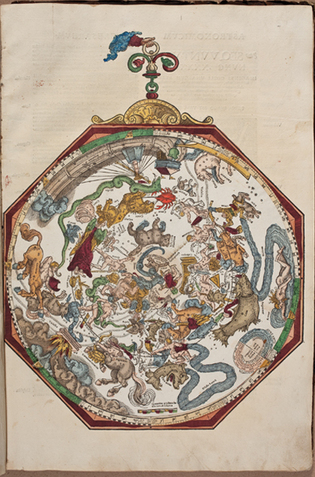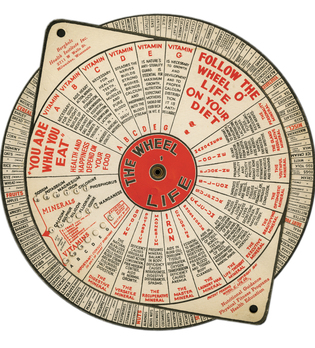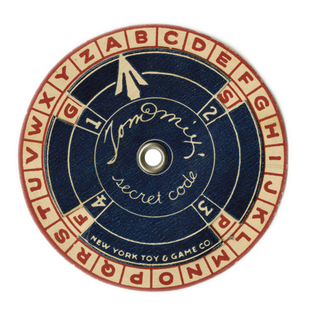 loading
loading
featuresGoing around in circlesVolvelles are those little paper wheels that help organize information. Yale has hundreds of them. Peggy Edersheim Kalb ’86 is senior editor of the Yale Alumni Magazine.  Cushing/Whitney Medical LibraryThis page from Petrus Apianus’s Astronomicum Caesareum (1540) features an embedded volvelle depicting stars and constellations. View full image Volvelle Collection, Robert B. Haas Family Arts LibraryThis nutrition guide was a gift to Jessica Helfand ’82, ’89MFA, from her father—the first volvelle in the collection she would donate to Yale in 2004. View full image Volvelle Collection, Robert B. Haas Family Arts LibraryThis undated volvelle helps users create a “secret code.” (Tom Mix starred in many silent Westerns.) View full imageOne of the collections in the Yale Arts Library consists of wheels: hundreds of complex paper wheels, each with moving parts, as if they were round paper slide rules. They are designed to convey information. What kind of information? Every kind. There are wheels to help you mix cocktails, at least one guide to the Old and New Testaments, and a guide to pricing Sunkist oranges. There is a “Mystiscope Fortune Teller” from 1925, billed as “the device that thinks.” The “Destination at a Turn of the Wheel Route & Mileage Chart” predated personal GPS by decades. The wheels are called volvelles. Although those in the Arts Library are modern, volvelles were in use in Europe by at least the thirteenth century. Today, though their functions have been largely replaced by computers, some are still produced. Pinterest offers online tutorials on how to make holiday card volvelles, and interior decorators use color wheels to preview color combinations. The early history of volvelles culminated in 1540, with a work by the astronomer to the court of Charles V, the Holy Roman Emperor. Astronomicum Caesareum (The Emperor’s Astronomy), by Petrus Apianus, included built-in volvelles that could be used to determine the positions of the planets at any given time and the dates of lunar eclipses. Copies of this extraordinary book—two of some 40 known to exist—are in the Medical Library and the Beinecke. According to Jessica Helfand ’82, ’89MFA, who teaches graphic design at Yale and donated the Arts Library volvelles in 2004, “of the 55 leaves [of the Astronomicum], 21 contain moving parts, and 12 more have index threads, several of which originally included tiny seed pearls to lock in location points.” Helfand’s own book on volvelles, Reinventing the Wheel (2002), features photos of most of the volvelles she donated. Helfand started her collection in her 30s. To her, modern volvelles are more than cultural oddities, more than tools we no longer need, and more than pieces of the history of design; they’re part of human history. “Such ephemeral novelties may not teach us how to compute planetary positions,” writes Helfand, “but they do reflect what we once ate and drank, what we looked at and wished for. They remind us, in the end, who we were.” |
|
4 comments
-

josh steinberg, 1:35pm March 18 2015 |  Flag as inappropriate
Flag as inappropriate
-

Ellen Harris-Braun, CPM, 6:57pm April 02 2015 |  Flag as inappropriate
Flag as inappropriate
-

Ellen Harris-Braun, CPM, 7:01pm April 02 2015 |  Flag as inappropriate
Flag as inappropriate
-

Mark Branch, 10:21am April 03 2015 |  Flag as inappropriate
Flag as inappropriate
The comment period has expired.I'm surprised that no mention was given to what I imagine is the most commonly used volvelle of them all: the pregnancy dating "OB wheel". Doctors for decades have always kept a cardboard calendar wheel in their pocket or in their desk so that within seconds we can see when a woman's due date is and how far along she is in pregnancy. With computerized medical records and smartphones, most wheels have been supplanted with electronic versions. But the wheels are still quite common. Contact me if anyone wants more info.
-- Joshua Steinberg MD, lead faculty for OB
UHS Wilson Family Medicine Residency
Binghamton NY
I too wanted to write in about the "pregnancy wheels," as they are often called. They are still in frequent use, and this article casts some light on an aspect of the wheels that I have been trying to share with my fellow midwives: they are not precision medical tools but giveaways from profit-making companies (as are most of the volvelles in your interesting article). One recent study showed that the wheels are often inaccurately designed or poorly calibrated and thus don't measure the prescribed 280 days of pregnancy that they purport to display. Therefore, if used to set a pregnant person's due date, some wheels will add in a few extra days, while other wheels will set the date a few days sooner than is correct. Midwives or OBs who use incorrect wheels will cause all their clients to have incorrect due dates. If pregnancy care providers knew the history of the pregnancy wheel as one among many promotional giveaways, perhaps we would not put our trust in them so blindly.
Here's a picture of a promotional pregnancy wheel: http://www.wellpromo.com/upload/upimg50/Pregnancy-And-Gestation-Calcul-42350.jpg
Thanks for your comments! It turns out that Helfand’s collection includes several “pregnancy wheels”; we’ll include a photo of one and your comments in our next Letters section.